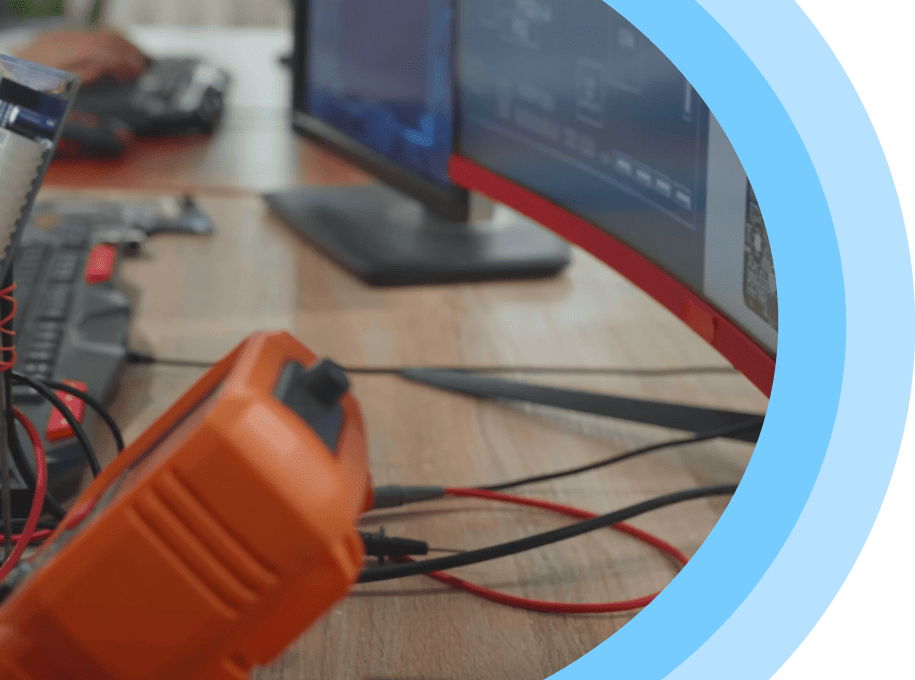New Batch Starts In a Week
A 5-month program covering Advanced C, Data Structures, PIC and LPC1313 (ARM Cortex M3), Linux Internals, and C++, offered in classroom and online modes to build complete embedded development skills.
Next Batch
1-1 Dedicated Mentor Support
24/7 Tool Access
Multiple Mock Interviews
Industry Standard Projects
Support with Resume Update
Embedded Systems Training Overview
Course Overview
Embedded Systems Training (VG-EMBEDDED) is 5 months course to enable engineers develop skills in full breadth of Embedded systems starting from Advanced C, Data Structures, LPC1313 Micro controller architecture with ARM Cortex M3 processor, Linux internals and C++. Training is offered in both classroom and online training modes. Embedded Systems Training in Bangalore is targeted towards BE, ME fresher’s and Engineers working in other domains planning to make career in Embedded systems domain. Course structure is framed keeping in mind the current industry requirements.
Embedded Systems Training divided in to multiple aspects, with training focused on all aspects from Embedded Systems basics, all industry standard micro controller architectures, Embedded C programming, standard interface protocols and multiple industry standard projects on Automotive. All these topics are covered with practical examples based on these boards.
Embedded Systems Training course also covers multiple hands-on projects based on industry standard Automotive LPC1313 micro controller. Learning starts from developing simple board based projects to complex projects involving multiple peripherals connected to make a complex Embedded system. All these projects are done from scratch. Course curriculum also ensures that student does these projects hands-on with trainer guidance as part of dedicated lab sessions.
Embedded Systems Training also includes 30+ detailed assignments (10 in C and Data structures, 10 in Micro controllers and Peripherals, 10 in Linux Internals). These assignments are prepared by industry experts covering all aspects from Embedded systems. Student gets to work on these assignments with complete guidance from trainers and student learning is evaluated using completion of assignments as the sole criteria. Student is offered with multiple (more than 10+) interview opportunities based on performance in assignments. Completion of all these assignments make a fresher as good as a 3+ year experienced engineer. That’s the quality of assignments!
VLSIGuru Institute has expertise in both VLSI and Embedded system domain. We have trained more than 1000 graduates over last 5 years since training was started in 2012. VLSIGuru Institute is rated among the Best Embedded Training Institutes in Bangalore .
Below is salient features of Embedded Systems Training course.
Introduction to Embedded Systems
C Programming on Embedded Systems
Fundamentals of C programming
C Data structures
Embedded Systems interfacing with peripherals
Micro controller Architecture
ARM 32-bit Micro-controller
Hands on projects
Linux Internals
C++ Programming
Find the Detailed syllabus topics for each section under Syllabus Tab.
Register for Embedded Training Institutes in Bangalore
INTRODUCTION TO C
- Design Methods
- Top Down Design
- Bottom Up Design
- Programming Languages
- Low Level language
- Machine Language
- Assembly Language
- High Level Languages
- Structure of C Program
Elements of C
- C Character set
- Alphabets
- Digits
- Special Characters
- Keywords/Reserved Words
- Data Types
- Constants
- Numeric Constants
- Character Constants
- String Constants
- Variables
- Variable Declaration
- Variable Initialisation
Operators And Expressions
- Arithmetic Operators
- Unary Arithmetic Operators
- Binary Arithmetic Operators
- Integer Arithmetic
- Floating Point Arithmetic
- Relational Operators
- Logical Operators
- AND (&&) Operator
- OR (||) Operator
- NOT (!) Operator
- Sizeof Operator
Control Statements
- If else
- Nesting of If else Ladder
- Else if Ladder
- Loops
- While Loop
- Do While loop
- For loop
- Nesting of Loops
- Infinite Loops
- Break statement
- Continue Statement
- Switch Case
Functions
- Advantages of Using Functions
- Library Functions
- User defined functions
- Function Definition
- Function Call
- Return Statement
- Function Arguments
- Types Of Functions
- Function with no Arguments and no Return type
- Function with no Arguments and Return type
- Function with Arguments and no Return type
- Function with Arguments and Return type
- Recursion
- Advantages and Disadvantages of recursion
- Local variables In recursion
Arrays
- One dimensional Arrays
- Declaration Of 1-D Array
- Accessing 1-D Array
- Initialisation of 1-D Array
- 1-D array and Functions
- Two dimensional array
- Declaration and Accessing of 2-D Array
- Initialisation of 2-D arrays
- Introduction to Strings
Pointers
- About Memory Organisation
- Address Operator
- Pointer Variables
- Pointer Addresses
- Pointer arithmetic’s
- Pointer to Pointer
- Pointer And 1-D array
- Pointer and 2-d array
- Pointers and Functions
- Function returning Pointer
- Array of pointers
- Void Pointers
- Dynamic Memory Allocation
- malloc()
- calloc()
- realloc()
- free()
Strings
- String constants and String Variables
- String Library Functions
- strlen()
- strcpy()
- strcmp()
- strcat()
- String pointers
- Array of strings
Structures and Unions
- Defining a structure
- Declaring Structure variables
- With structure Definition
- Using Structure Tag
- Initialisation of Structure Variables
- Accessing of Members of structures
- Storage of Structures in Memory
- Structure Bit-Fields
- Sizeof structures
- Array of Structures
- Arrays within Structures
- Pointers to Structures
- Pointers Within Structures
- Structures and functions
- Self Referential structures
C Preprocessor
- #define
- Macros and Macros With Arguments
- Nesting in Macros
- Problems with Macros
- Macros vs Functions
- Conditional Compilation
- Predefined Macros
- #pragma directive
Operation on Bits
- Bitwise AND(&&)
- Bitwise OR(|)
- Bitwise XOR(^)
- Bitwise Right Shift(>>)
- Bitwise Left Shift(<<)
- One’s Compliment
- Masking
- Bit fields
Storage Classes
- auto
- register
- static
- extern
Linked list
- Introduction to single linked list
- Traversing a single linked list
- Inserting an element in SLL
- Deleting a node from SLL
- Question on rearranging an SLL
- Question on moving last node to front of list
- Printing the elements of SLL using recursion
- Recursive program to reverse an SLL
- Doubly linked list
- Circular linked list
- Problems on DLL and CLL
Stacks and Queues
- Introduction to stacks
- Implementing of stacks using arrays
- Linked list implementation of stack
- Implementing of queue using arrays
- Implementing of queue using Linked list
- Implementation of queue using circular array
- Infix to postfix conversion algorithm
- Postfix evaluation algorithm
- Problems on Stacks and queues
Trees
- Introduction to tree traversals
- Implementation of traversals and time and space analysis
- Double order traversal
- Triple order traversal
- Number of binary tress possible
- Recursive program to count number of leaves and non leaves
- Recursive program to find the height of tree
- Binary search Tree
- Problems on BST
Introduction to ARM Cortex m3 Introduction to LPC 1313 Memory Architecture GPIO Handling
- Configuring General Purpose Input and Output Module
- Switching the Peripherals (on / off)
- Signaling LED’s
- Monitoring the User Keys…etc
- LED Blinking
Analog Joystick
Analog touch Sensor Analog Encoder Seven Segment Display LCD ADC
- Implementation of Analog to Digital Converter
- Observing LM35(Temperature)
- Analog Voltage Measurement (POT)
- Finding Analog Joystick Positions
DA PWM
- Implementation of Pulse Width Modulation
- Motor Speed Control
- Light Intensity Control
- Buzzer Sound Control
Timers
- Implementation of Timers
- We Can Implement Task Scheduler
- For Counting Events
- For Encoder Pulses
Systic timer
NVIC Interrupts UART
- Implementation of Universal Asynchronous Receiver and Transmitter
- See the Controller data at live time in another Screen
- Send Instructions to Machine when it is running
- Perform Simplex communication
I2C
- Implementation of Inter Integrated Circuit
- Transmitting the Data from Master to Outside Slave
- Saving the Live Data in EEPROM
- Handling Real Time Clock
SPI
- Implementation of Serial Peripheral Interface
- Processor to Processor Communication
- Handling DAC with SPI
- Sending data to MAX7219(4 digit SSD)
CAN
- Elaboration of Control Area Network
- Real time data Transmission
- Data Security
- Filtering data
- Error Handling
Cooperative task Scheduler
- Implementation of Co-operative Task Scheduler
- Periodic Execution of tasks
Real Time Projects
- Project1 : Setting Factory Defaults
- Usage: Fix vehicles speed limit, rpm, engine Temperature etc.
- Project2 : Smart Home Automation
- Usage: You can able to Set any electronic device when to ON and When to OFF or Automatically sensing etc.
Interview Point of Questions
1. Operating System
- What is an operating system
- Why Linux?
- Linux Kernel Architecture
2. The Process
- Process State
- Process Control Block
- Context Switch
- CPU scheduler
- Dispatcher
3. Scheduling Algorithms
- FIFO Scheduling Algorithm
- Round robin
- Priority Based Scheduling
- Shortest Job First
4. Processes
- Creating Sub process with fork
- Synchronising With the Creator process
- System commands
- The Process Table
- Orphan and Zombie Process
5. Threads
6. Signals
7. The Operating System Interface
- What are System Calls?
- System call Interface
8.Inter-Process Communication
- Pipes
- What is Pipe?
- Parent and Child Processes
- Reading closed Pipes
- FIFO
- Accessing a FIFO
- Client/Server Using FIFO
9. Process Synchronisation
- Need of Synchronisation
- Introduction to Synchronisation Mechanisms
- Conditions for Synchronisation Mechanisms
- Lock Variables
- TSL
- TSL Question
- Disabling Interrupts
- Turn Variable or Strict Alteration Method
- interested Variable
- Peterson Solution
- Tracing Peterson Solution
- Sleep and Wake
10. Introduction to Semaphores
- Counting Semaphores
- Problems on Counting Semaphore
- Binary Semaphore or mutexes
11. Threads
- Introduction
- Threads Creation
- Thread Termination
- Thread Synchronization
- Mutexes
- Semaphores
- Reentrancy
12.Inter Process Communication
- Message Queues
- msgget
- msgsnd
- msgrcv
- msgctl
- Shared Memory segment
- shmget
- shmat
- shmdt
- shmctl
- Semaphores
- Semaphore Definition
- Linux semaphore Facilities
- Using Semaphore
13. Memory Management
- Memory Hierarchy
- Virtual memory
- Fragmentation and Compaction
- Dealing with Fragmentation
- Page Table in Memory
- Memory allocation with Paging
- Sharing the processor and sharing Memory
- Swapping
- Page Tables
- Levels of page Table
- Page Table Hierarchy
- Page Tables problem
- Page Replacement
- Page Replacement Algorithms
- Virtual to Physical address translation
- Two level Translation
- Three level Translation
14. DeadLocks
- What is Deadlock?
- Why Deadlock is a problem?
- Conditions for Deadlock to Occur
- How to deal with Deadlock
- Deadlock Prevention
- Deadlock Avoidance
- Deadlock Recovery
- Deadlock Handling Mechanisms
- Bankers Algorithm
- Resource allocation Graph
1. Introduction
- Why C++
- Difference Between C and C ++
- Procedural Oriented Programming Language
- Object Oriented Programming Language
2.What is C++
- Features of C++
- Data Encapsulation
- Data Abstraction
- Polymorphism
- Inheritance
3. Basic Input Output Statements in C++
- The standard output stream(count)
- C++ program Structure
- Compiling and Executing C++ Program
- Namespaces
- New Datatypes in C++
4. Scope Resolution Operator
- Syntax of Scope resolution operator
- References
- C++ References vs Pointers
- C++ pointers vs References
5. Function Overloading
- What is function Overloading
- Default Values in parameters
- Argument passed by value and reference
- Inline functions
- What is Inline function?
- Reason for the need of Inline Function
- Difference between Inline functions and Macros
- Advantages of Inline functions
6. Class
- What is Class?
- Features of Class?
- How to Write a Class?
- Access Specifiers
- Creation of Objects
- Data Encapsulation Example
- Malloc and New
7. Friend Classes
- Friend functions
- Friend Classes
- Class Member Functions and Classes as Friends
- Friend Declarations
8. Constructors
- Types of Constructors
- Default Constructor
- Parameterized Constructor
- Copy Constructor
- Destructor
9. Operator Overloading
- Operator overloading Restrictions
- Operator overloading of Different Unary and Binary Operators
10. Inheritance
- Inheritances Between classes
- Types of Inheritance
- Single Inheritance
- Multiple Inheritance
- Multi Level Inheritance
- Hybrid Inheritance
- Hierarchical Inheritance
11. Polymorphism
- Pointers to Base class
- Abstract base classes
12. Templates
- Function Templates
- Class Templates
- Advantages of templates
13. Exception Handling
- Exceptional Behaviour
- Facing an Exception
- Catching Multiple Exceptions
- Nesting Exceptions
- Group discussions will be running throughout the course

Key Features
Who All Can Attend This Embedded Systems Training?
This training is designed for professionals looking to develop strong skills in designing and programming embedded systems used in a wide range of electronics. It suits both beginners aiming to enter the field and experienced engineers seeking to enhance their hardware-software integration expertise.Pre-requisites To Take Embedded Systems Training
- Exposure to C Language programming
- Exposure to any processor architecture
- Exposure to some standard interface protocols like I2C, SPI, GPIO etc
- Above all is good to know, however trainer will start from basic concepts without any assumptions on student exposure to above topics
High Demand for Embedded Systems Training
Know about the Growing VLSI industry
Embedded Systems Engineers are the backbone of hardware-software integration. Salaries grow steadily with experience in microcontroller programming, RTOS, and debugging. Bangalore, Pune, and Hyderabad are top-paying hubs due to the concentration of electronics and IoT companies.
₹5 LPA
₹8 LPA
₹11 LPA
₹14 LPA
₹17 LPA


- Customized training programs for teams
- Upskill and reskill employees with industry-relevant content
- Interactive sessions led by expert trainers
- Hands-on projects and real-world case studies
- Flexible delivery in online
- Improve productivity and efficiency
- Access to training resources and material

- Learn in real-time with instructor-led sessions
- Flexible access from anywhere
- Recorded sessions available for revision
- Training on industry-standard tools
- Get certification after completion

- Self-paced learning as per your flexibility
- Industry-aligned learning modules
- Certification after course completion
- Access to structured video lessons and materials
- Track your progress step by step
- Access to learning materials for more than 1.5 years
This 5-month Embedded Systems Training equips engineers with comprehensive skills from Advanced C and microcontrollers to Linux internals and C++, aligning with current industry needs. Targeted at freshers and those seeking a career shift, it emphasizes hands-on projects, industry-standard automotive applications, and extensive assignments. Successful completion aims to elevate a fresher's skills to the level of a 3+ year experienced engineer, offering significant career advantages.
Career Path
Learning Path

At VLSIGuru, we believe that education should lead to meaningful employment. Our training programs are designed not just to impart technical excellence, but also to bridge the gap between academic learning and industry demands. With a strong network of hiring partners and a proven track record, we ensure that our students are career-ready.
Placement Highlights
- Industry-aligned curriculum
- Hands-on projects and case studies
- Communication skills
- Resume building and interview preparation
- Technical and HR mock sessions
- Aptitude and domain-specific test series
- Regular drives and exclusive hiring events with partner companies
- Resume building and interview preparation

At VLSIGURU, we provide industry-focused VLSI training and guidance that helps students and professionals build strong technical skills and succeed in their careers. Our programs are designed to be practical, flexible, and aligned with current industry requirements.
Student Reviews




Frequently Asked Questions
- Course presentations for all topics
- Session notes
- Lab documents with detailed steps
- User guides
- Exposure to C Language programming
- Exposure to any processor architecture
- Exposure to some standard interface protocols like I2C, SPI, GPIO etc
- Above all is good to know, however trainer will start from basic concepts without any assumptions on student exposure to above topics
- Course will cover multiple Hands on Embedded Systems Projects based on Raspberry Pi & PIC Microcontroller. These projects are integrated in to each session of course giving practical overview of each aspect learnt.
- Ex: While learning Interface protocols like GPIO, SPI, I2C, we will use Raspberry Pi board to teach how these protocol communication work on board.
- Course has been framed by industry veteran (Girish Kumar) with 16+ years of industry experience
- Course will be completely executed by Girish Kumar (Previously manager with Cisco Systems)
- Embedded systems training course is offered both classroom and through online
- Online sessions will be done using gotomeeting.com
- Student has option to attend a demo session (for both class room & online) before registering for course
Each session of course is recorded, missed session videos will be shared
- Yes, You will have option to view the recorded videos of course for the sessions missed
- You will have option to repeat the course any time in next 1 year
- Yes, Course fee also includes support for doubt clarification sessions even after course completion
- Student has option to mail queries or clarify doubts in person
VLSI Guru's embedded systems courses are designed to help students gain a strong foundation, freshers acquire industry-relevant skills for entry-level positions, and working professionals transition into the core embedded systems domain or upskill for career advancement. The courses often include hands-on projects, practical learning, and placement assistance to make candidates industry-ready. For working professionals looking for a career transition, the courses aim to build a solid resume as an Embedded Professional.
Yes, it is generally possible to enroll in an embedded course at VLSI Guru even without prior experience. Many foundational courses are designed to take individuals through a systematic skill-building approach starting from the basics.
Upon completing the Offline Embedded Systems course at VLSI Guru, you will likely receive a certification of completion from the institute. This certificate acknowledges your successful completion of the training program and the skills you have acquired.
Yes, VLSI Guru typically offers online courses for Embedded Systems certification, providing flexibility for students to learn remotely. They may also offer hybrid models that combine online and offline learning.
Skills in Embedded Systems open up a wide array of career opportunities, including roles such as:
- Embedded Systems Engineer
- Embedded Software Engineer
- Embedded Hardware Engineer
- Firmware Engineer
- IoT Engineer
- Software Test Engineer (for embedded systems)
- Embedded Systems Trainer
According to the Indian Institute of Embedded Systems, the uniqueness of their placement-oriented courses lies in the measurable outcomes that participants achieve in Embedded hardware and Embedded Firmware related skills upon completion. This suggests a focus on practical skills directly applicable to industry requirements.
Yes, VLSI Guru typically provides both online and offline training options for Embedded Systems, offering flexibility to cater to different learning preferences and locations.
The modules covered in an embedded systems course at VLSI Guru can vary depending on the specific course and its level. However, typical modules might include:
- Fundamentals of C programming and Embedded C
- Microprocessors and Microcontrollers (e.g., ARM, PIC)
- Operating System concepts
- Real-Time Operating Systems (RTOS)
- Data Structures and Algorithms
- Device Drivers
- Communication Protocols (e.g., UART, I2C, SPI, CAN)
- Interfacing with peripherals and sensors
- Introduction to Embedded Linux (in some advanced courses)
- Internet of Things (IoT) basics (in relevant courses)
The specific hardware boards you will work on during your embedded systems course at VLSI Guru would depend on the course curriculum. Common hardware platforms used in embedded systems training include:
- Arduino boards
- Raspberry Pi boards
- PIC microcontrollers
- ARM-based development boards (e.g., STM32, NXP)
- BeagleBone boards


